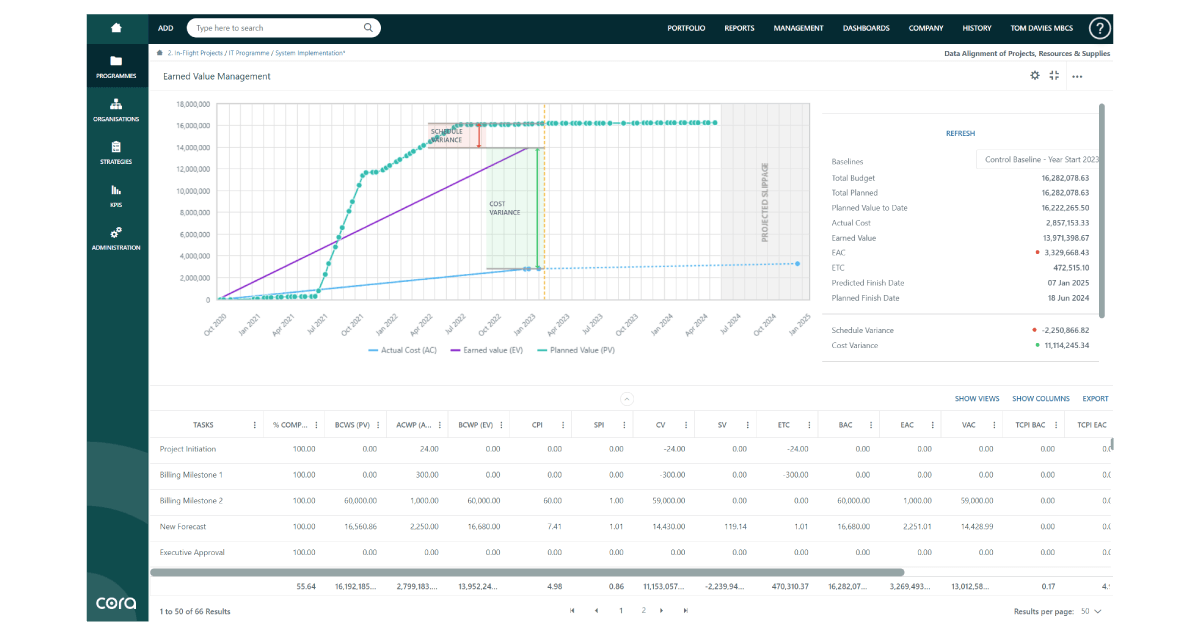
Earned Value Management (EVM) is a project management methodology that enables you to integrate scope, cost and schedule, so that you can accurately and objectively measure project performance.
Table of Contents
Earned Value Management Systems (EVMS)
What is Earned Value Management?
How Does Earned Value Management (EVM) Work?:
Benefits of Earned Value Management
Cora Earned Value Management (EVM) Module
Earned Value Management began life as the Program Evaluation and Review Technique (PERT), which was introduced by the U.S. Navy in 1957 to help it manage Polaris, its nuclear submarine project.
It quickly came to be used in conjunction with the critical path method (CPM), the algorithm designed to help businesses schedule their project activities more effectively, which had been introduced the year before.
Different versions of PERT emerged throughout the 1960s as the Department of Defense (DoD) became increasingly focused on reining in the costs of its projects. But the constant modifications it kept making undermined people’s trust in it.
Earned Value Management Systems (EVMS)
Eventually, in 1996, the DoD introduced its Earned Value Management Systems (EVMS) which had 32 specific criteria, with the aim of establishing a standardized method that could be used for any project, in any industry.
That concern with costs is well merited. Every year there are stories of yet another large (often mega) project that’s gone over budget or has been badly delayed. The DOD, and the government in general, fund a large number of these complex, capital-intensive projects and if any of them go over budget or get delayed, it understandably attracts a great deal of scrutiny.
The result is that EVMS have become one of the most important elements in the government contracting (GovCon) industry.
What is Earned Value Management?
Earned Value Management (EVM) is a project management methodology that enables you to integrate scope, cost and schedule, so that you can measure project performance by comparing where you actually are, with where you were forecast to be. This allows you to predict where the project is actually going.

How Does Earned Value Management (EVM) Work?
Understanding how EVM works can be intimidating, as it’s invariably explained using equations, graphs and a host of acronyms. But essentially, it revolves around three elements and the way they interact.
Planned Value (PV) is the budget cost for work scheduled, or BCWS, and tells you where you were supposed to be by whatever date or period you’re looking at, in terms of costs and schedule.
Actual Cost (AC), or actual cost of work performed (ACWP), gives you the amount that the project has actually needed to date. Which can be calculated from when the project began, or over a specific time period within the overall schedule.
Earned Value (EV), or budgeted cost for work performed (BCWP), gives you the amount that’s been spent to complete whatever’s been delivered to date, regardless of where the project was meant to be by this stage.
The key insight that EVM gives you are the variance values that these three elements produce, which can be expressed as a percentage or as an index.
At its most basic level, you subtract EV from PV to see if there’s been any schedule variance (SV), which you can then express as a percentage. A minus percentage tells you how much you’re behind schedule, a plus how much ahead you are, while ‘0’ demonstrates you’re on schedule.
Similarly, you get your cost variance (CV) by subtracting AC from EV, which gives you your CV percentage.
Benefits of Earned Value Management
EVM provides enterprise organizations with a wide range of benefits that produce quantifiable improvements to their bottom line, and numerous academic studies have demonstrated how effectively it improves forecasting and planning.
Specifically, it enables you to benchmark a project’s progress against established baselines to identify critical paths. This gives you better visibility into where a project is at any given moment in time, improving the decisions that result.
Crucially, it does so by providing you with data and insights that are objectively evaluated. Instead of having to rely on individual assessments that are subjectively reached, you can stand back to produce objectively calibrated solutions that are founded on quantifiable data.
This is why it’s become the methodology of choice for so many industries, especially throughout the GovCon sector.
Cora EVM Module
The Cora EVM module provides a comprehensive range of Earned Value Techniques (EVTs), including: percentage complete, level of effort (LOE), weighted milestones with quantifiable back-up data (QBD), fixed formula (XX/YY), program evaluation review technique (PERT) and apportioned effort.
Find out more on our Earned Value Management Toolset here.







